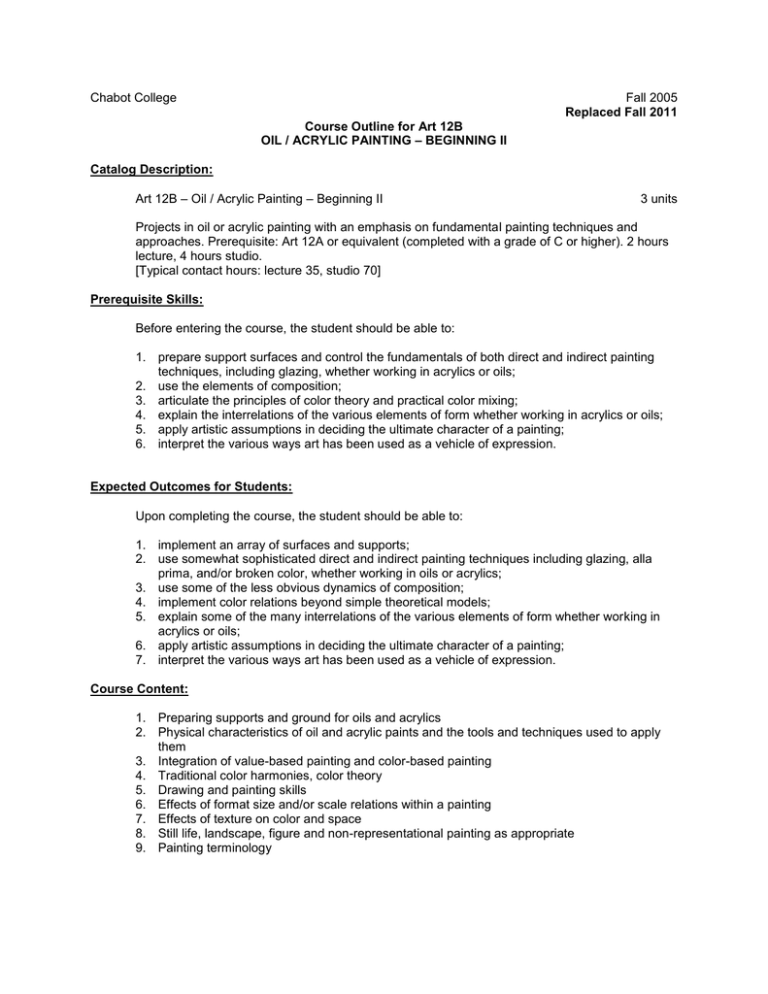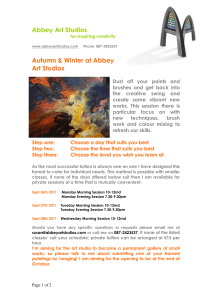Chabot College Fall 2005 – Oil / Acrylic Painting – Beginning II
advertisement

Chabot College Fall 2005 Replaced Fall 2011 Course Outline for Art 12B OIL / ACRYLIC PAINTING – BEGINNING II Catalog Description: Art 12B – Oil / Acrylic Painting – Beginning II 3 units Projects in oil or acrylic painting with an emphasis on fundamental painting techniques and approaches. Prerequisite: Art 12A or equivalent (completed with a grade of C or higher). 2 hours lecture, 4 hours studio. [Typical contact hours: lecture 35, studio 70] Prerequisite Skills: Before entering the course, the student should be able to: 1. prepare support surfaces and control the fundamentals of both direct and indirect painting techniques, including glazing, whether working in acrylics or oils; 2. use the elements of composition; 3. articulate the principles of color theory and practical color mixing; 4. explain the interrelations of the various elements of form whether working in acrylics or oils; 5. apply artistic assumptions in deciding the ultimate character of a painting; 6. interpret the various ways art has been used as a vehicle of expression. Expected Outcomes for Students: Upon completing the course, the student should be able to: 1. implement an array of surfaces and supports; 2. use somewhat sophisticated direct and indirect painting techniques including glazing, alla prima, and/or broken color, whether working in oils or acrylics; 3. use some of the less obvious dynamics of composition; 4. implement color relations beyond simple theoretical models; 5. explain some of the many interrelations of the various elements of form whether working in acrylics or oils; 6. apply artistic assumptions in deciding the ultimate character of a painting; 7. interpret the various ways art has been used as a vehicle of expression. Course Content: 1. Preparing supports and ground for oils and acrylics 2. Physical characteristics of oil and acrylic paints and the tools and techniques used to apply them 3. Integration of value-based painting and color-based painting 4. Traditional color harmonies, color theory 5. Drawing and painting skills 6. Effects of format size and/or scale relations within a painting 7. Effects of texture on color and space 8. Still life, landscape, figure and non-representational painting as appropriate 9. Painting terminology Chabot College Course Outline for Art 12B, Page 2 Fall 2005 Methods of Presentation: 1. 2. 3. 4. Studio lectures, discussion and demonstrations Examples of student and professional work Slides and videos Museum and/or gallery visit with an appropriate exhibition Assignments and Methods of Evaluating Student Progress: 1. Typical Assignments a. Portray motion. Paint a composition that expresses the vitality of motion or dynamic movement. As a motif, select an event, or a physical subject in movement. For example, it can be a recollection or a photographed image from a track and field event, a dance performance, a football game, a circus event, a sports car rally, a machine in motion, etc. The subject, in fact, can be human, animal, or mechanical. b. Extruded Color. Paint using color extrusion, defined for the purpose of this experiment as simply the process of squeezing acrylic paint out an ordinary plastic squeeze bottle. This technique requires no brushes; instead “drawing” and “painting” is done entirely with squeeze containers, each one loaded with a different color or value, according to the required color scheme. 2. Methods of Evaluating Student Progress: a. Assigned projects, comprehension and applications of the terms and concepts of each project b. Class work c. Student output d. Development of craftsmanship e. Overall presentation and professionalism in presenting completed painting projects f. Final portfolio Textbook(s) (Typical): Artists Illustrated Encyclopedia: Techniques, Materials and Terms, Philip W. Metzger and Phil Metzger, Northlight Books, 2001. Special Student Materials: 1. 2. 3. 4. acrylic or oil paints canvases and stretcher bars brushes and mediums various applicable materials DZ g:\Curriculum2005\Art12B Revised: kk ch 10/27/04





